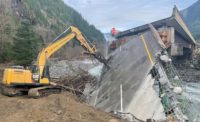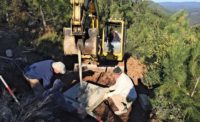...he began to scheme for the creation of a hurricane that he could capture and turn on and off to test the assembled components in buildings that all too often fail—even when they individually carry heavy- weather ratings.
“We need to get rid of all the smoke screens that come up after these events,” he says, describing how the material manufacturers and installers invariably start blaming each other’s work whenever building systems fail. Rather than performing forensic analysis on piles of wreckage, scientists using the new facility will measure the loads and methodically create that wreckage, in the presence of sensors and high-speed video cameras, for scientific analysis.
“One goal is to get data we can’t get any other way,” says Cope, who also studied storm damage under Reinhold at Clemson. “The other goal is to get compelling video,” she says. It was car-crash test videos that slapped the auto industry into a higher state of safety, she notes. She hopes videos of buildings being destroyed by storms will lead to similar results.
Styled for Purpose
The campus includes an 11,000-sq-ft office and conference building, built of precast concrete and heavily insulated against sound, but finished to resemble a local farmhouse. Tommy Dew, project architect with Odell Associates, Charlotte, says the office building is styled to evoke the purpose of the facility—to lead the way to building stronger, safer homes.
Then there is the nearly 42,000-sq-ft test facility itself, including its 145-ft square test chamber with 60-ft-tall clear span and a turntable that lets test subjects be rotated to simulate shifts in wind. The early involvement during design development of construction manager Holder Construction Co., Atlanta, is credited with influencing the decision to go with precast construction, rather than the steel, Quonset hut-style-enclosure originally envisioned.
A fire pit that runs the length of the windward side will permit the generation of a rain of flying embers. Four remotely operated water cannons on the floor and a high-volume sprinkler system on a retractable grid provide fire protection. There is an observation area and control room behind glazing rated for 180 mph winds.
The fan array and its stack of tunnels is structurally independent of the main building. The fan tower is designed to support 8,000 lb of thrust from any one fan, as well as overall maximum thrust of 400 kps, according to structural engineer John Lyons, a principal of Walter P. Moore Associates’ Atlanta office.
The tower is made of precast concrete, which was selected as a durable substrate for mounting the 9,130-lb fans. The mass also “mitigates vibration,” Lyons says. Stability along the axis of the chamber is provided by the load-bearing walls. Transverse stability is provided by external 12-in.-deep precast buttress walls. Smooth interior surfaces reduce air turbulence.
The control systems include a heavily air-conditioned, 3,413-sq-ft electrical building to house banks of Rockwell variable-frequency drives to modulate electrical current frequency and control fan speeds. A Duke Power substation crouches just outside the door.
Finally, there is a 750,000-gal water tank with a supporting pump room for the fire-suppression system and for delivering torrential rains during testing..
The project is so special that the head of its mechanical-electrical and controls engineer, United Engineering Group Inc., Charlotte, decided he would serve as project engineer rather than hand the task to another senior staff member. “It was such an unusual project I did it myself,” says Don Pettigrew, United’s president.









Post a comment to this article
Report Abusive Comment